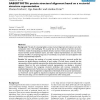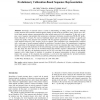148 search results - page 4 / 30 » The evolutionary capacity of protein structures |
BMCBI
2005
13 years 7 months ago
2005
Background: Protein domains have long been an ill-defined concept in biology. They are generally described as autonomous folding units with evolutionary and functional independenc...
BMCBI
2007
13 years 7 months ago
2007
Background: The task of computing highly accurate structural alignments of proteins in very short computation time is still challenging. This is partly due to the complexity of pr...
NAR
2008
13 years 7 months ago
2008
The Structural Classification of Proteins (SCOP) database is a comprehensive ordering of all proteins of known structure, according to their evolutionary and structural relationsh...
BMCBI
2008
13 years 7 months ago
2008
Background: Residue depth allows determining how deeply a given residue is buried, in contrast to the solvent accessibility that differentiates between buried and solvent-exposed ...
JCC
2008
13 years 7 months ago
2008
: Knowledge of structural classes is useful in understanding of folding patterns in proteins. Although existing structural class prediction methods applied virtually all state-of-t...


